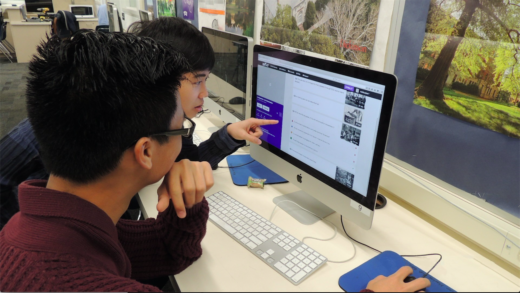Some weeks ago, I asked all 140 students to either work alone, or in groups of 2-3, to produce a 15-question, multiple choice Kahoot quiz, with each Kahoot quiz relating to a particular chapter of the text.
Click below to view a 2:02-minute video filmed, edited and uploaded to YouTube by junior Hanna Von, showing not only the steps my students took to produce their Kahoots but also what it looked like when my 3rd-period class took a Kahoot quiz produced by a student in my 2nd-period class.
If you are a high school U.S. History teacher and would like to present any one of my student-produced Kahoots to the students in your class, click here.
Process and Procedure
Before asking my students to produce a Kahoot of their own, I asked junior Wesley Huang to field test the concept. Needless to say, I was quite impressed with his work.
With a successful field test behind me, I decided to have all of my students make a quiz of their own. I let each student choose whether or not he/she wanted to work alone, or in a group of 2-3 students. I then directed my students to do the following:
- Create a Google Doc (so that they could collaborate, in real time, at school or from home).
- Write 15 multiple-choice questions in the Google Doc, making sure that all questions (a) pertain to the most important content covered in their assigned chapter, and (b) steer clear of Kahoot’s 95-question character limit. (I wanted each quiz question to be brief and to the point, rather than wordy and complicated).
- Find an image online that relates to each question.
- Find an image online that relates to the title of the chapter assigned.
Students were then given two class periods to produce their Kahoot. During this period of time, the students also received some “teacher advice” on how to write good quiz questions. “No trivial pursuit questions. No silly or ridiculous answer choices. Both questions and answers should be worded in a way that can be deemed neither vague nor ambiguous. No grammar or punctuation errors, etc.”
Looking back, I wish I had also directed the students to read the following:
Students were then given two more class periods to engage in peer reviews of their various Google Doc/Kahoot quiz Q&A drafts. My hope was that incorporating peer reviews into the process would help my students become better writers, readers and collaborators. In this regard, I wish I had looked to Planning and Guiding In-Class Peer Reviews. Next time.
Upon completion of the peer reviews, I asked a number of my students whether the peer reviews had led them to produce better-worded questions and answers. Unanimously, the students said yes.
The students were then given one more period to score the quizzes produced by their classmates.
The Scoring Rubric
Click here to view a simple yet effective 16-point rubric that I created for the purpose of scoring the student-produced Kahoots.
The Student-Produced Kahoot and the Common Core
For teachers wondering to what extent a project like this can be justified given the amount of time needed to complete it, teachers need only look to the Common Core Standards. There, teachers are expressly called upon to provide their students with a chance to write for “a range of discipline-specific tasks, purposes and audiences.”
Alternatives to Kahoot
There’s a lot to like about Kahoot: it’s free, capable of working on tablets, smartphones, and computers, and (as your students will surely agree), it’s a super engaging, user-friendly way to check for understanding. But there are also many great Kahoot alternatives (Alternative’s to Kahoot – 2018)
Final Thoughts
When all was said and done, I asked some of my students to answer the following question: “On a scale of 1 to 10, to what extent did you find this project interesting, informative and engaging (with a 10 being very interesting, informative and engaging, and a 1 being not at all interesting, informative and engaging)?”
On average, the students scored it a 7 and I was satisfied with this response, though I would have found something less than a 7 to be troubling.
In any event, I think Kahoot would have earned a higher average score if the students hadn’t bucked up against either the 95 character per question limit or the 65 character per answer limit. Both of these character limits forced the students to create questions/answers that weren’t “challenging enough,” to some.
However, I also heard from my students that the character limits not only forced them to keep their Q&As short and sweet, but that they also forced them to produce a quiz that their fellow classmates would not perceive as unfairly complex.
In any event, from my vantage point, the students as a whole appeared to get into this project.
I was particularly impressed with how they worked to come up with such well-thought-out and well-worded questions. I was even more impressed to hear them justify, in response to peer review questions, why they asked the questions that they did. And they all seemed to thoroughly enjoy playing the games produced by their fellow classmates.
Given the above, I will therefore provide my students with a chance to produce a Kahoot of their own in the years to come.
